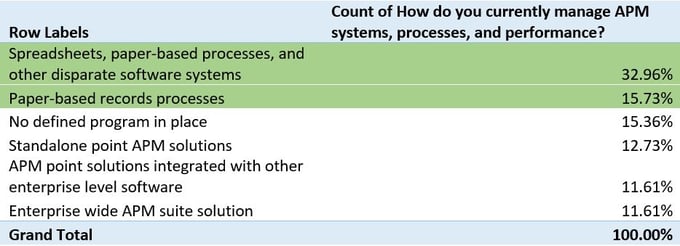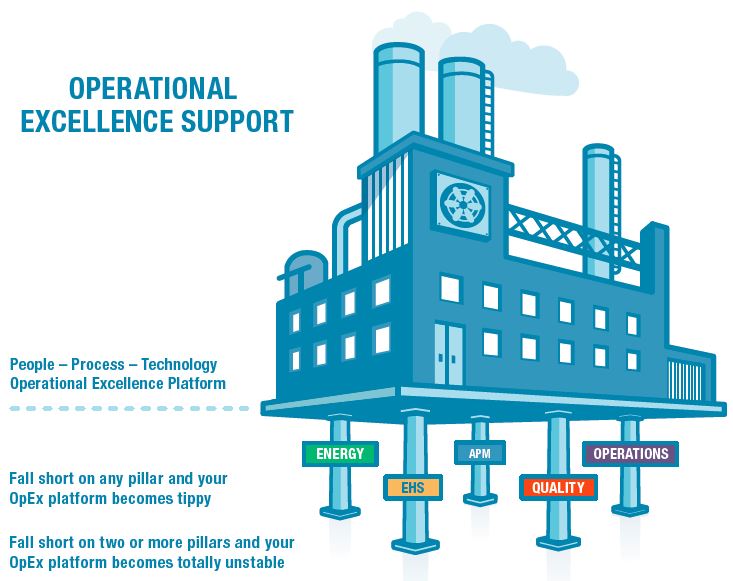Utilities are constantly balancing growth in power needs while meeting changing compliance standards and environmental regulations. As the industry evolves with more Smart Connected Assets and an unfolding power generation and distribution mix (wind, solar, stored power), Chief Operating Officers (COOs) will need to consider Asset Performance Management in order to use critical maintenance and engineering information to support Operational Excellence initiatives.
To ensure all levels of the organization achieve the full potential that APM has to offer, this blog post's goal is to review the top three considerations when COOs look to move forward with a world class Asset Performance Management effort
1. Move from Excel Spreadsheets to Enterprise Solutions
In our APM survey over 48% of respondents reported that they manage systems, processes, and performance using paper or spreadsheets. This is a dangerous approach when considering the effect of a catastrophic events. COOs should ask themselves:
- How does our organizations calculate the impact associated with asset failures?
- In the event of failure, can we identify our process to understand the issue and our attempts to remediate?
- As assets, people, and data change, how do we ensure we have a single version of the truth?
With spreadsheets it is difficult to understand and document processes and information to support the decision making process around assets. A better way is to invest in enterprise solutions. Enterprise solutions incorporate workflows and ways to document approval processes on why and how to make changes to the asset infrastructure. These solutions take advantage of the various data sources within the organization to evaluate the risk of assets and the effect of change. The outcome is a formal decision making process based on relevant information, whith checks and balances to ensure better operational decision making and a safer operating environment.

2. Start with a Dedicated APM Leader and Reporting Structure; Establish an APM Team
Organizations are more apt to fail when they lack the required leadership and team committed to the strategic objective at hand. It is pointless to invest time and money into people, processes, and technology without having the responsibility held at the highest levels of the organization.
To increase chances of success organizations should consider not only assigning a dedicated leader to their APM initiatives, but providing the right team with the power to make and keep recommended changes. All too often in Utilities, APM is tested and evaluated through small pilot projects, then shelved as a new project takes priority. COOs should involve and assign high level leadership to empower the APM team. This will lead to a higher payback and improved operational efficiencies in the long run.
3. Align APM With Other Corporate Initiatives Such as Quality, Energy, EHS, and Operations
APM is as important as Energy, Quality, EHS, and Operations Management and if it is not treated as such, Operational Excellence initiatives will suffer. A common area often overlooked by COOs when enabling APM is ensuring its alignment with other initiatives. LNS Research refers to this as the five pillars of Operational Excellence. APM, along with Energy Management, EHS, Quality and Operations are the main components.
Falling short in one area can result in vulnerability; if more pillars yield it can result in catastrophic failure. It’s important for Utilities to understand that when asset reliability and performance is poor, it not only impacts the APM processes, but affects and has implications with other operational programs too. To ensure successful implementation of APM, the recommendation is to align your APM goals and objectives with the operational groups assigned to these pillars; otherwise it’s destined to fail.

COOs at Utilities that do not have an enterprise approach, enable APM within their organizational design and do not include APM as part of their Operational Excellence initiatives face a challenging environment. COOs should focus on the three areas when enabling APM in order to reduce risk of asset failures and have the ability to track and document when they do occur. Using spreadsheets won’t cut it in an asset intensive environment like Utilities.
Organizations that succeed in APM implementations start out on the right foot with the right people assigned to the right roles and with sponsorship from senior leadership. We also recommend to COOs willing to make the enterprise solution investment in APM to evaluate vendors who document customer case stories. As Utilities mature into APM organizations, COOs can expect to gain operation visibility and insight that helps predict asset failures leading to better cost controls and increased power production and distribution operational efficiencies.
Understand the capabilities of twenty of the leading vendors in the APM space by downloading our APM Solutions Section Guide. The guide contains comparison charts for the factors listed above and the detailed profiles of the twenty vendors ranging from automation companies, to enterprise software providers and includes many specialized APM solutions as well.